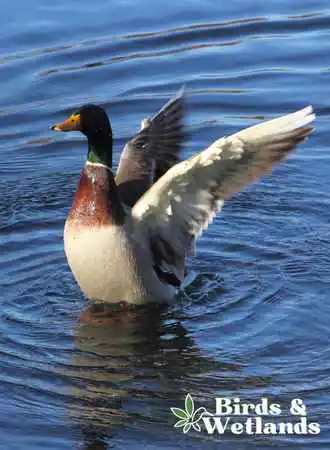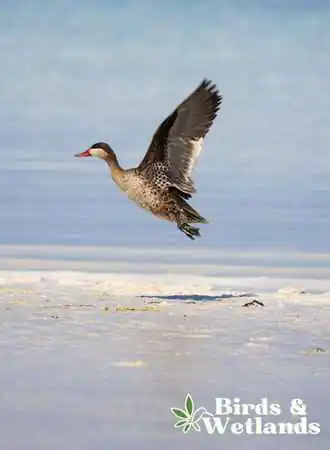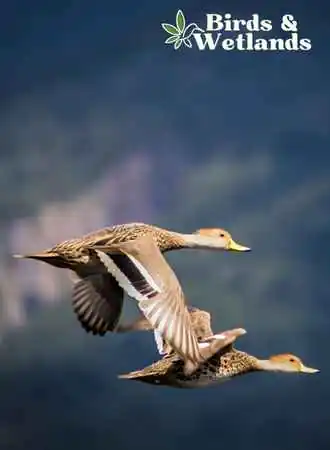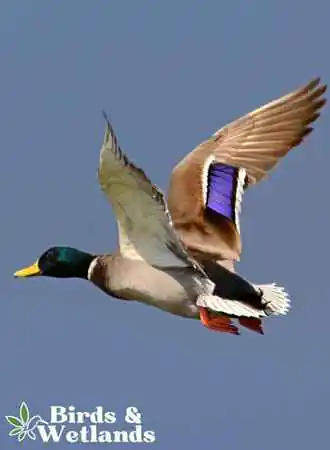Many ducks can fly, but not all ducks fly. Ducks that can fly do so during winter when they migrate to the warmer climate in search of suitable habitats and food resources.
Yes, most species of ducks are capable of flight. They are strong fliers, often migrating long distances between different habitats in different seasons. Some domestic duck breeds, however, have been bred to be larger and heavier than their wild counterparts and may have more difficulty taking flight. Some examples of such breeds are Pekin and Muscovy ducks. It’s also worth noting that ducks need open space to take off and land as they fly almost horizontally.
Key Takeaways on Can Ducks Fly
- Ducks belong to the family Anatidae and are generally categorized as dabbling ducks, diving ducks, or sea ducks.
- Many duck species can fly, particularly during migration; however, some domestic breeds cannot due to size, weight, and wing structure.
- Ducks have curved, pointed wings and powerful wing muscles that allow them to fly long distances.
- Ducks fly for various reasons, including migration to warmer climates or breeding grounds.
- Ducks can reach altitudes up to 22,000 feet during migration and speeds of 40 to 60 miles per hour.
Can Ducks Fly?

Ducks can fly, but they are not exactly renowned for it. They lack stamina and are less agile in flight than other birds. Also, ducks can’t fly backwards.
Still, ducks are capable fliers and use their wings for more than just traveling. They use their ability to fly to travel short distances, during migration and to avoid predators.
Although ducks typically take off from either land or water when they take flight, they can reach impressive speeds and heights. They can take off from land or water. For instance, a diving duck can take off from the water. Ducks remain a vital part of avian ecosystems despite their flight limitations.
The Muscovy duck and the Mallard both can fly, while the Pekin duck and Indian runner ducks can’t.
| Duck Species | Can They Fly? | Maximum Flying Speed | Maximum Flying Altitude | General Habitat | Migratory? |
|---|---|---|---|---|---|
| Mallard | Yes | 55 mph | 4,000 feet | Freshwater & seawater | Yes |
| Indian Runner | No | N/A | N/A | Domestic | No |
| Pekin | Mostly No | N/A | N/A | Domestic | No |
| Eider | Yes | 60 mph | N/A | Seawater | Yes |
| Red-breasted Merganser | Yes | 100 mph | N/A | Freshwater & seawater | Yes |
| Ruddy Shelduck | Yes | N/A | 22,000 feet | Freshwater & seawater | Yes |
| Cayuga | No | N/A | N/A | Domestic | No |
| Rouen | No | N/A | N/A | Domestic | No |
| Falkland Steamerduck | Mostly No | N/A | N/A | Seawater | No |
| Northern Pintail | Yes | N/A | N/A | Freshwater & seawater | Yes |
How Do Ducks Fly?
Ducks are widespread birds that live in every content except Antarctica. These birds use specialized anatomical features and advanced flying techniques to travel long distances. These waterfowl migrate thousands of miles to reach warmer or more hospitable climates during migration.
A duck’s ability to fly is largely due to its wings, which are curved with pointed tips that enable it to generate lift and travel long distances with little effort. Furthermore, their powerful wing muscles allow them to flap continuously, regardless of how big or small their wings are.
Furthermore, the duck’s body structure assists in its flight proficiency by supporting its weight with specially-designed wing coverts and primary and secondary flight feathers. As a result of these flapping motions and gliding movements, the duck maintains its airborne position. Their tail feathers act as a rudder while in flight.
Interestingly, during the molting season, when ducks lose their flight feathers, they are unable to fly.
Ducks also use specialized techniques and flight patterns like formation flying to enhance their effective flight. You can see ducks flying in flocks in a V-formation. Most migratory birds that travel in formation save energy by taking advantage of each other’s wind patterns and aerodynamic designs.
In a V-formation, the lead bird heads the group, with each bird flying slightly above the one in front. By doing this, ducks with relatively small wings can fly long distances.
Wild ducks usually fly in flocks with other ducks, especially when baby ducks are old enough to have gained flight. This usually happens about five to eight weeks from hatching. A group of ducks flying together can spot potential predators quickly than a duck flying alone.
At the start of breeding season, some ducks fly in what it many call “three bird flights” formation. Essentially, this formation is formed when three birds, one drake and two females fly together.
How Fast Can Ducks Fly?
Ducks are fun-loving water birds capable of flying at fast speeds. Some ducks can reach speeds of around 40 to 60 miles per hour. While these speeds may not seem very fast at first glance, it’s important to remember that this is an average speed, and individual ducks may often fly at much faster rates.
For instance, eiders can reach speeds of 60 miles per hour, while a red-breasted merganser (diving ducks) can fly at speeds of 100 miles per hour. This is most likely the fastest duck ever recorded.
On the other hand, blue-winged and green-winged teals are quite slow regarding flight speed. These waterfowl can only reach speeds of about 30 miles per hour when in flight.
How Far Can Ducks Fly?

Most birds migrate to escape the frigid temperatures of the north. It is well known that ducks migrate extensively and in impressive numbers. In a year, many ducks cross large bodies of water and navigate rugged terrain, covering thousands of miles. Ducks must make these long journeys because seasonal food availability changes can majorly impact their survival.
As temperatures drop and food becomes scarce in the fall, most ducks migrate south. They can travel across continents and even oceans to reach warmer winter climates.
As spring arrives, many ducks will begin traveling back to their nesting grounds, often venturing farther north than they previously had to find more stable food sources.
Adaptability to climate change and finding new food sources throughout the year depend on ducks’ migration ability. However, most of these birds will lose much of their body weight during long distance migration so they need three to seven days to fully recover.
How High Can Ducks Fly?
Ducks are famous for their incredible flying abilities, allowing them to glide through the air easily and gracefully. While it is widely assumed that ducks can fly at extremely high altitudes, the precise height at which they can fly is quite variable.
During migratory flights, ducks typically fly between 200 and 4000 feet above the ground. Some duck species, however, have been known to reach even greater heights.
For instance, it has been reported that a jet plane flying over Nevada struck a mallard flying at an altitude of 21,000 feet. Ruddy shelducks fly at an average altitude of 17,000 feet.
Why Do Ducks Fly?
There are duck varieties that can survive freezing temperatures and due to the lack of nerves and blood vessels in their webbed feet, some of these ducks can tolerate cold water. Still, many species of waterfowl fly short distances or longer to escape winter.
Despite being quite large and having small wings disproportionate to their bodies, ducks possess an innate ability to fly. Migrating, escaping predators, and searching for food are some important functions your feathered friends perform when they fly.
Ducks fly south for the winter. As temperatures drop in autumn, ducks take to the skies, using powerful flapping wings to soar long distances over land and water until reaching warmer climates where food is more abundant.
Flying also allows ducks to evade predators such as eagles or hawks. Through flying, these vulnerable waterfowl can distance themselves from their would-be attackers.
One of the reasons why ducks migrate during the winter is to search for better food sources. A typical duck’s diet consists of aquatic plants and small fish. However, these foods are not always easily accessible.
By flying over large plains or dense forests, ducks can spot trees full of nuts or ponds teeming with fish, allowing them to feed more efficiently and stay healthy in the long run.
Can Ducks Fly at Night?

Ducks are capable fliers, even at night. This ability stems from their eyesight and navigational skills being uniquely adapted.
Ducks such as Northern Pintails can fly at night. This is due to their superior vision and ability to navigate and orient themselves in low-light conditions.
Their eyes are placed on the sides of their heads to provide a wide field of vision, allowing them to see well in low light. Furthermore, they have extra-large pupils that can dilate to let more light in.
Ducks have excellent navigational skills too. They rely on instinctual cues like magnetic fields and star patterns, as well as internal maps of geographical landmarks like lakes, rivers, and mountains.
Because of these advanced capabilities, even long-distance wild birds can fly at night with little difficulty or risk. With these adaptations in mind, it appears clear a wild duck has what it takes to soar through the night skies!
Can Domestic Ducks Fly?
You may be wondering, can farm ducks fly? The answer is no.
Many domesticated ducks are typically larger than wild ducks, owing to artificial breeding practices that select for traits like size and meat production.
Domestic ducks cannot fly or even take off from the ground due to their size and weight. Instead, they use alternative modes of transportation such as walking, swimming, and waddling. This inability to fly makes them more vulnerable to predators and prevents them from reaching food sources that would otherwise be inaccessible.
Despite these disadvantages, domestic ducks provide numerous advantages to farmers and home growers. They are simple to care for and frequently produce many eggs and valuable feathers.
However, some domestic Mallards and Muscovy ducks can still fly but not as far and high as their wild counterparts.
Can Runner Ducks Fly?
Indian Runner ducks are domestic ducks with long, slender bodies and an upright stance. Runner ducks, unlike other types of domestic ducks, can walk and run rather than waddle.
While runner ducks have many distinguishing physical characteristics, their ability to fly is perhaps the most notable distinction between them and other duck breeds.
Runner ducks, like most domestic duck breeds, cannot fly. No matter how hard they flap, these domesticated birds simply cannot get off the ground.
Can Mallard Ducks Fly?

Most wild ducks fly, and Mallards are no different. Mallard ducks are dabbling ducks that are well-known for their exceptional flying abilities. These hardy birds are naturally adept at flying long distances, using a combination of powerful flapping motions and flexible wings to glide from one location to another.
A wild Mallard can even reach extremely high altitudes, making them ideal for gliding across vast expanses of open water without colliding with obstacles.
Can Pekin Ducks Fly?
Pekin ducks are distinguished by their large, stocky bodies and flattened webbed feet. These traits make them excellent swimmers but also influence how the birds fly.
Pekin ducks are unable to fly. While a Pekin duck can take short hops or jump a short distance off the ground, its relatively large size and dulled wing feathers do not allow for sustained flight. In fact, Pekin ducks frequently lose altitude and crash land if they attempt to fly more than a few feet above the ground.


